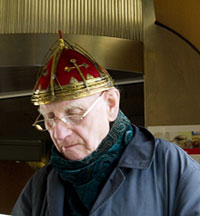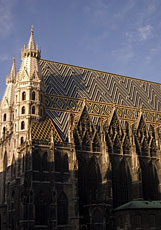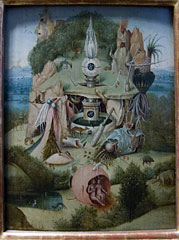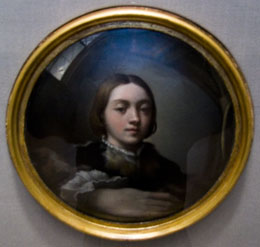Unreflected
I haven’t written much about the actual traveling lately, chiefly because it’s been by automobile which just isn’t very interesting and for some reason seems to put me to sleep, which it never used to do. Before this trip I was a dedicated driver, I’ve driven coast to coast across the U.S. six times and countless trips through the west, new England and the south (I once did LA to Atlanta in 26 hours straight through), but for some reason I’ve lost my taste for driving. So I was actually elated when we ditched the car in Prague and hopped a train for Vienna. Public transportation is much much better, you can relax, have a beer and meet strangers with funny hats.
 Of course sometimes public transportation breaks and you find yourself in Slovakia instead of Austria, but these things are temporary. Usually. Or at least in this case it was. We spent a few hours loitering on Slovakian tracks waiting for another train to pass and then continued on in a roundabout way to Vienna during which time I was regretfully reminded of the inanity involved in conversing with Young American Males.
Of course sometimes public transportation breaks and you find yourself in Slovakia instead of Austria, but these things are temporary. Usually. Or at least in this case it was. We spent a few hours loitering on Slovakian tracks waiting for another train to pass and then continued on in a roundabout way to Vienna during which time I was regretfully reminded of the inanity involved in conversing with Young American Males.
Vienna is a strange city; one I had trouble wrapping my head around at first. The old town area lies inside the Ringstraße (hereafter referred to as Ringstrasse because writing out that entity in html is a pain)[1]. The Ringstrasse is a wide circular boulevard that runs, as its name implies, in a circle around the old city center. Inside the Ringstrasse are the fantastically massive Hapsburg Palace, several large churches and the upscale tourist destinations, hotels, shops and that sort of thing. The old city is ostensibly closed to traffic, though that doesn’t see to stop the taxis, and consequently it’s the tourist hub of Vienna.
Though I’m sure it was a carefully studied urban planning venture, which on paper sounds like a beautiful idea, a vehicleless downtown full of street markets, cafes, cobblestones and coffeehouses, in practice the Ringstrasse effectively isolates the center of Vienna and it left me feeling a bit trapped. Though I was excited to leave the car behind in Prague, I found myself once again seemingly wedged and isolated by vehicles as I watched a dizzying circle entrapping downtown visitors like corralled cattle. One afternoon I sat on a bench beside the Ringstrasse, smoking cigarettes under the still dripping leaves of an elm tree, watching the traffic ferry past like a scene in Koyaanisqatsi, and started to wonder if Frogger was by chance designed by an Austrian.
 After a day or two wandering among the Baroque facade of St. Stephens Cathedral, snacking of vast arrays of sausage and cabbage, learning to love oversize pints of hefeweizen, and generally avoiding all things castle or palace-like, I finally ventured out to the Kunsthistorisches Museum (which is admittedly not actually outside the Ringstrasse, but something about just seeing the vast open space just beyond the boulevard made me feel like I was again part of a city rather than stuck in a hole, cut off in the middle of a city).
After a day or two wandering among the Baroque facade of St. Stephens Cathedral, snacking of vast arrays of sausage and cabbage, learning to love oversize pints of hefeweizen, and generally avoiding all things castle or palace-like, I finally ventured out to the Kunsthistorisches Museum (which is admittedly not actually outside the Ringstrasse, but something about just seeing the vast open space just beyond the boulevard made me feel like I was again part of a city rather than stuck in a hole, cut off in the middle of a city).
The Kunsthistorisches Museum contains probably the best collection of art outside of France — Rubens, Rembrandt, Vermeer, Raphael, Velazquez, Bruegel and a certain Italian for whom I have a festering personal obsession, which shall be addressed shortly — and what’s remarkable about this magnificent assemblage is that the vast majority of it was once the Hapsburg’s private collection. The history of European ruling families is soaked in money, petty squabbles, the occasional inbreeding and plenty of sordid underbellies, but some of these families did have remarkable aesthetic vision in spite of their various handicaps. Yes I do think that wealth and power are handicaps to understanding the world around you because they remove you from the intricate struggles of everyday life and that in turn is a handicap to anything that might be called the development of an aesthetic sense based on something more than whim, fancy or cultural popularity, but let’s be clear that handicaps are not insurmountable as the Hapsburg collection attests, which is to say that occasionally rich people are able to grasp greatness.
It had just stopped raining when I made my way from our penzion over to the Kunsthistorisches Museum, rivulets of water ran between the cobblestone cracks and seeped through the long since worn-through soles of my shoes which caused my socks to make disturbing squishing sounds as I walked. The sky was a heavy leaden grey and looked as if it might start again the chilly drizzling rain that had been hanging around ever since we arrived. After paying the requisite fees and obtaining an audio guide (which I generally never bother with but for some reason on that day I felt the need to hear a voice), I wandered about the foyer for a minute absorbing the heavy baroque ceilings three stories overhead and the dark wood floors scuffed by the feet of the millions who passed through before me.
I had come mainly to see the works of Hieronymus Bosch, or at least out the painters mentioned in the brochure at our penzion, Bosch was the only one I found exciting. If you’ve never seen a Hieronymus Bosch painting they can be a bit shocking, especially considering he was painting around the turn of the 16th century. Bosch mixed mysticism, realism, religious symbolism, highly cerebral sense of irony, and magical iconography into a phantasmagoric stew that puts to shame the later so-called surrealists. Though I don’t know that much about either of them Bosch and William Blake always come together in my mind.  Carl Jung called Bosch “The master of the monstrous… the discoverer of the unconscious,” which could just as easily be applied to Blake. Philip II of Spain bought up the vast majority of Bosch’s work long ago, and I probably shouldn’t have expected to find much at the Kunsthistorisches Museum since I already knew most of his work is in the Prado Museum in Madrid, but I was a bit disappointed to find there were only two paintings in the Kunsthistorisches (The Adoration of the Kings is at the Metropolitan Museum of Art in New York for those looking for something closer to home).
Carl Jung called Bosch “The master of the monstrous… the discoverer of the unconscious,” which could just as easily be applied to Blake. Philip II of Spain bought up the vast majority of Bosch’s work long ago, and I probably shouldn’t have expected to find much at the Kunsthistorisches Museum since I already knew most of his work is in the Prado Museum in Madrid, but I was a bit disappointed to find there were only two paintings in the Kunsthistorisches (The Adoration of the Kings is at the Metropolitan Museum of Art in New York for those looking for something closer to home).
Having rushed impatiently through the museum to find the Bosch, which, was every bit as gorgeous as I had hoped, though I was disappointed that the one I liked, Paradise, or Allegory of Vanity, didn’t have an audio tour entry, I retraced my steps and wandered about the maze-like floor plan absorbing Dutch and Flemish painters whose names rang like a distant telephone you can hear, one you have in fact been hearing for years, but have never bothered to answer; maybe you didn’t know it was a telephone, perhaps it just sounded like a murmur, that far off tone of the alarm clock before the world resolves itself out of sleep and becomes an actual object, a thing, an alarm, a phone, a Vermeer. But as semanticists are always pointing out, objects are not actually things, they are events, molecules arriving simultaneously at a lavish ballroom party, spinning, coalescing and collapsing in time to become what we call an object. And I don’t mean that to be some overwrought analytical deconstruction, but rather as a beautiful thing, an object, whether it be a Vermeer or a Nokia, is an event happening, one which we can participate in, can join in, in fact can not avoid since the event happens solely so that we may see it. And from that perspective there is no historical burden to carry about, no cultural/political/social constructs to worry about, simply a painting coming together in the moment as our eyes sweep across it, which isn’t to say that history, context and culture are irrelevant, rather they are optional, they are the gowns and tuxedos of the arriving molecules, the historical costumes of events which sometimes enrich our experience and sometimes stifle it with their gaudiness.
Off in the side corridor of the Italian wing I rounded a corner still listening to my audio guide rattle on about Rembrant and rather abruptly came face to face with a painting I had been wanting to see for years — Self Portrait in a Convex Mirror (my photograph is less than stellar, for a much better image see the Web Gallery of Art version which allows for zooming and enlarging).
I originally came across Parmigianino through the title of John Ashbery’s[2] noted collection of poems, Self Portrait in a Convex Mirror. Parmigianino’s painting of the same title was the inspiration and graces the cover of Ashbery’s book. There is that old adage about judgment and books and covers and things you ought not to do and yet I have often found that in fact sometimes you can judge a book by its cover and Ashbery’s collection is, to my mind, such an example. I spent hours of class time studying that painting while others wrestled with the intentions and slippery meanings of the words inside.
What I never realized until I walked up to it in the Kunsthistorisches Museum, is that the actual painting is convex. Parmigianino had a ball of wood milled and them he sliced off the face of it to have convex surface on which to work. And that’s just the beginning of the complexities of Self Portrait.
 What drew Ashbery and countless other critics to the painting are the subtle layers within it. Painted as a testament of personal skill, Parmigianino presented the canvas along with two others to Pope Clement VII hoping for a commission. Some have suggested that the enlarged forearm and hand are meant to suggest the artists skills, a sort of mildly disguised bit of self promotion, which sounds fine until you remember that if this is indeed what Parmigianino saw in a convex mirror, then the arm thrust forward is the left arm, not the right, which is traditionally associated with the painter’s skills. This is perhaps one of the more trivial points in the painting, but it hints at the kind of layers of meaning and mystery which Parmigianino managed, whether intentional or not, to work into the painting.
What drew Ashbery and countless other critics to the painting are the subtle layers within it. Painted as a testament of personal skill, Parmigianino presented the canvas along with two others to Pope Clement VII hoping for a commission. Some have suggested that the enlarged forearm and hand are meant to suggest the artists skills, a sort of mildly disguised bit of self promotion, which sounds fine until you remember that if this is indeed what Parmigianino saw in a convex mirror, then the arm thrust forward is the left arm, not the right, which is traditionally associated with the painter’s skills. This is perhaps one of the more trivial points in the painting, but it hints at the kind of layers of meaning and mystery which Parmigianino managed, whether intentional or not, to work into the painting.
There is within this small (just under 10 inches in diameter) painting so much to dwell on that I spent several hours studying it (Luckily for me there was a chair against the wall just opposite).
I am not an art critic nor am I a fan of the open-ended scholarly interpretation crap I just indulged in, but I do like to be able to say with some clarity, why I like something rather than simply leave it as self evident or begging the question, and yet it is very hard to say why I like this painting. After spending so much time with it, which I can assure is about one hour and fifty minutes longer than I’ve ever spent looking at any other painting, I realized it’s the distortion within the distortion that compels me, the reflection of what isn’t, reflected again in pigment, it’s an opening of worlds, a stabbing at understanding which underlies all our endeavors in some way, a recognition of the complexities within complexities. I would like to see another painting of someone looking between two convex mirrors such that an infinite series of outwardly telescoping reflections was created.
When I was younger I travelled a good deal with my parents mainly camping in the southwestern US. My parents had a 1969 Ford truck with a camper on top. The size and shape of the camper necessitated large mirrors that extended out quite a ways from the door. The main mirror was rectangular and flat, a one to one reflection, but in the lower right corner of the large mirror a small convex mirror had be glued on to provide a wide angle view. Since I generally rode in the passenger’s seat of the truck I spent most of the time staring at my distorted reflection, moving my hand in and out with the rush of wind watching it grow larger and more unnaturally arched and warped the closer I brought it to the mirror.
The first time I saw Parmigianino’s Self Portrait on the cover of Ashbery’s book I thought of the truck mirror and the millions of associations that came with those memories. Self Portrait came over time to amalgamate a collection of previously forgotten or overlooked memories until it attached itself and in many way became an inseparable part of the memories themselves. Rather than bandying about under the weight of historical context or canonical scholarship, it collapses now as an event in my own life.
My friend Mike said something to me the other day about realizing that it’s fairly easy to find your way through a house of mirrors if you simply stare at your feet, but then, what’s the fun in that? He’s right and similarly, life can be fairly simple if you stare at the ground and don’t worry to much about what’s going on a round you, but the point of the house of mirrors maze isn’t to solve it, to get to the end and leave, the point is stumble about, bump into walls, into other people, into your own distorted reflection and have fun while you do it. And in some way that’s the pleasure I find in Parmigianino’s Self Portrait in a Convex Mirror, a reminder that the distortions are the real adventure, the real enjoyment and also the real truth.
-
1. For language nerds (because I know some of you are): That entity, the ß, or Eszett as it’s known, is a ligature of a long s dating from before the middle ages when ss was a separate letter of the alphabet (in English as well). The Eszett is fading out in modern German (officially dropped by the Swiss years ago and as anecdotally told to me by my friend Jackie, not all that common in modern Germany either), but its usage is still quite popular in Austria. According to the German Spelling Reform of 1996 the letter “ß” is to appear only after long vowels and diphthongs. ↩
-
2. As with anyone who has studied 20th century literature I passed through a certain period in which I became semi-obsessed with John Ashbery. Lots of post grad poetry students (I used to hang around with a lot of post grad poetry students) seem to think it’s passé to extol someone as popular and widely established as John Ashbery, but that’s just silly. I still, along with Wallace Stevens, Bernadette Mayer, Frank Stanford and Alice Notley consider him to be one of the truly great writers of our times. ↩
Thoughts?
Please leave a reply:
All comments are moderated, so you won’t see it right away. And please remember Kurt Vonnegut's rule: “god damn it, you’ve got to be kind.” You can use Markdown or HTML to format your comments. The allowed tags are
<b>, <i>, <em>, <strong>, <a>. To create a new paragraph hit return twice.